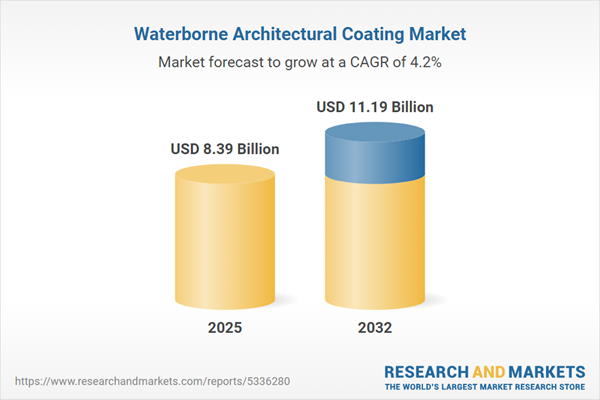Speak directly to the analyst to clarify any post sales queries you may have.
Senior executives navigating the waterborne architectural coating market must adapt quickly to regulatory shifts, evolving sustainability requirements, and ongoing technological innovation, all of which drive the need for agile strategies and robust operational planning.
Market Snapshot: Waterborne Architectural Coating Market Growth
The global waterborne architectural coating market is advancing due to increased construction activities and a growing emphasis on environmentally responsible solutions. Stricter environmental regulations, coupled with modernization and refurbishment initiatives, are compelling industry players to develop coatings that deliver on lifecycle value and compliance. Manufacturers are investing in product innovation to address changing client needs and expectations for durability, ease of use, and regulatory alignment. As sustainability and compliance standards tighten, high-demand construction and renovation projects are increasingly driving senior decision-makers to evaluate solutions that deliver both operational value and dependable environmental performance.
Scope & Segmentation in the Waterborne Architectural Coating Market
This report offers strategic, actionable insights to support executive-level planning and informed investment across the waterborne architectural coating sector, enabling optimized resource deployment and operational effectiveness.
- Functions: Primers, sealers, and coatings engineered for high moisture resistance, superior stain protection, and enhanced adhesion, applicable in a range of indoor and outdoor environments.
- Product Types: Alkyds for consistent application, acrylics designed to meet changing environmental regulations, styrene acrylic emulsions for flexibility, epoxies tailored for challenging conditions, and polyurethanes offering surface durability.
- Applications: Solutions for new builds, complex renovations, structural upgrades, and specialized restoration projects, each with unique scheduling and regulatory demands.
- Distribution Channels: Direct sales, manufacturer partnerships, OEM arrangements, omni-channel approaches, and expanding e-commerce capabilities to maximize operational agility and reach.
- End Use: Customized coatings designed for commercial, industrial, hospitality, office, and residential sectors, each subject to distinct compliance and operational frameworks.
- Regional Analysis: Coverage includes North America, Europe, Asia-Pacific, and Middle East & Africa, focusing on supply chain requirements and regional regulatory factors influencing market accessibility and local growth.
- Technology Trends: Advances such as improved resin performance, digital color management, use of artificial intelligence for greater efficiency, and integrated systems supporting circular economy models and waste reduction.
- Company Profiles: Detailed perspectives on key players including PPG Industries, Sherwin-Williams, Akzo Nobel N.V., Nippon Paint Holdings, Asian Paints, Kansai Paint, RPM International, Jotun, Hempel, and Berger Paints, with a focus on innovation and competitive positioning.
Key Takeaways for Senior Decision-Makers
- Embedding sustainability into every stage of operations ensures differentiation and alignment with evolving environmental and customer standards in the waterborne architectural coating market.
- Early adoption of emerging resin technologies and additives allows for preparedness against upcoming regulatory changes and shifting buyer expectations.
- Strong supplier relationships at the regional level are essential for minimizing disruptions caused by supply chain instability.
- Developing strategic alliances with contractors and equipment suppliers expedites compliance and streamlines project timelines under tightening regulatory obligations.
- Utilizing digital platforms, including analytics and IoT solutions, increases responsiveness to market changes and supports flexible, data-driven decision-making.
Tariff Impact: Navigating the 2025 U.S. Adjustments
Forthcoming adjustments to U.S. tariffs on critical input materials are driving waterborne architectural coating companies to reevaluate procurement and logistics. For senior leaders, this means proactively amending supplier contracts, optimizing network logistics, and adjusting sourcing strategies to reinforce supply chain stability. These measures minimize the risk of operational interruptions and ensure business continuity, especially under greater regulatory evaluation.
Methodology & Data Sources
This analysis employs thorough secondary research, direct interviews with industry executives, consultations with expert panels, and targeted field studies. The blended approach ensures that insights are both credible and relevant for executive-level strategic and operational planning, supporting dynamic market adaption.
Why This Report Matters
- Enables alignment of R&D and capital investment with current compliance trends and emerging industry priorities.
- Facilitates agile adjustments in product portfolios and processes to support multinational management teams amid evolving regulatory landscapes.
- Equips senior leadership to proactively address policy changes with adaptive strategies suited to competitive market realities.
Conclusion
Sustained progress in the waterborne architectural coating industry relies on informed leadership, strategic adoption of new technologies, and resilient supply partnerships that together foster operational flexibility.
Additional Product Information:
- Purchase of this report includes 1 year online access with quarterly updates.
- This report can be updated on request. Please contact our Customer Experience team using the Ask a Question widget on our website.
Table of Contents
3. Executive Summary
4. Market Overview
7. Cumulative Impact of Artificial Intelligence 2025
Companies Mentioned
The companies profiled in this Waterborne Architectural Coating market report include:- PPG Industries, Inc.
- The Sherwin-Williams Company
- Akzo Nobel N.V.
- Nippon Paint Holdings Co., Ltd.
- Asian Paints Limited
- Kansai Paint Co., Ltd.
- RPM International Inc.
- Jotun A/S
- Hempel A/S
- Berger Paints India Limited
Table Information
| Report Attribute | Details |
|---|---|
| No. of Pages | 183 |
| Published | October 2025 |
| Forecast Period | 2025 - 2032 |
| Estimated Market Value ( USD | $ 8.39 Billion |
| Forecasted Market Value ( USD | $ 11.19 Billion |
| Compound Annual Growth Rate | 4.1% |
| Regions Covered | Global |
| No. of Companies Mentioned | 11 |









